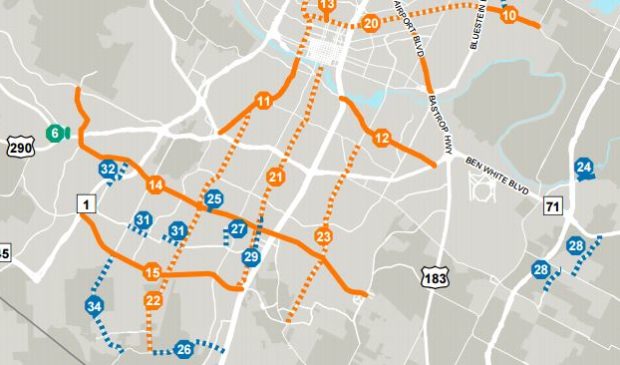Updated: City dives into corridor studies with southern region sessions
Wednesday, May 24, 2017 by
Chad Swiatecki Austin’s Transportation Department is moving ahead with efforts to determine what should be done with the $482 million in corridor improvements voters approved last fall as part of the $720 million mobility bond. Thus far the department has completed six corridor mobility reports, with a seventh nearly finished with two more in South Austin just underway.
The completed corridor studies are for portions of North Lamar Boulevard, Burnet Road, Airport Boulevard, East Martin Luther King Jr. Boulevard, South Lamar Boulevard and East Riverside Drive, with the report for Guadalupe Street expected to be completed soon. Improvements in those corridors are budgeted in the bond project, as are improvements to Slaughter Lane and William Cannon Drive, though they have just begun to be studied.
Corridor studies on five additional corridors are also being funded through the bond program, as is preliminary phase work on three more. Design and construction for recommendations in those corridor studies is not budgeted in the bond package.
Residents near that fast-growing South Austin corridor have attended a series of public meetings this month on improvements needed in the area, which transportation officials said has seen a dramatic increase in traffic due to businesses and schools attracting east-west commuters. Those roads also attract use because they serve as major connectors between I-35 and Mopac Expressway for north-south travelers.
This week’s meetings saw residents weighing in on issues such as poor sidewalk connectivity, access to transit options, general safety problems and an increase in difficulty for residents trying to leave their neighborhoods during high-traffic periods.
“That area has changed a lot in about the last 15 years by being a connector route and seeing more schools and employers moving in,” said Anna Martin, the department’s south area engineer. “We’re hearing about things like the long interval between traffic signals on East William Cannon, and the major points of congestion on Brodie Lane and Slaughter.”
The southern corridor data will be compiled into initial recommendations over the summer, with a final plan expected in the fall.
The reports for each corridor will make up a major component of the overall bond project, and are intended to work in concert with other studies such as the Capital Metropolitan Transportation Authority’s Project Connect.
“For this and several other corridors it made sense to look and see what the next set of solutions could be,” said Mike Trimble, director of the Corridor Program Implementation Office. “The city gets plenty of 311 calls about different issues in an area, but this is the better way to look at how to make it easier to live, work and get around.”
Download (PDF, 583KB)
This story has been corrected to include information that Slaughter Lane and Wiliam Cannon corridor projects are underway and funded by the bond package. The story has also been updated to include information that five additional corridor studies are being funded through the bond program, as is preliminary phase work on three more.
The Austin Monitor’s work is made possible by donations from the community. Though our reporting covers donors from time to time, we are careful to keep business and editorial efforts separate while maintaining transparency. A complete list of donors is available here, and our code of ethics is explained here.
You're a community leader
And we’re honored you look to us for serious, in-depth news. You know a strong community needs local and dedicated watchdog reporting. We’re here for you and that won’t change. Now will you take the powerful next step and support our nonprofit news organization?








